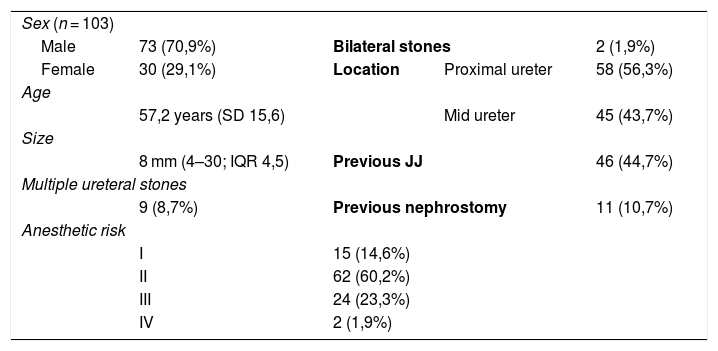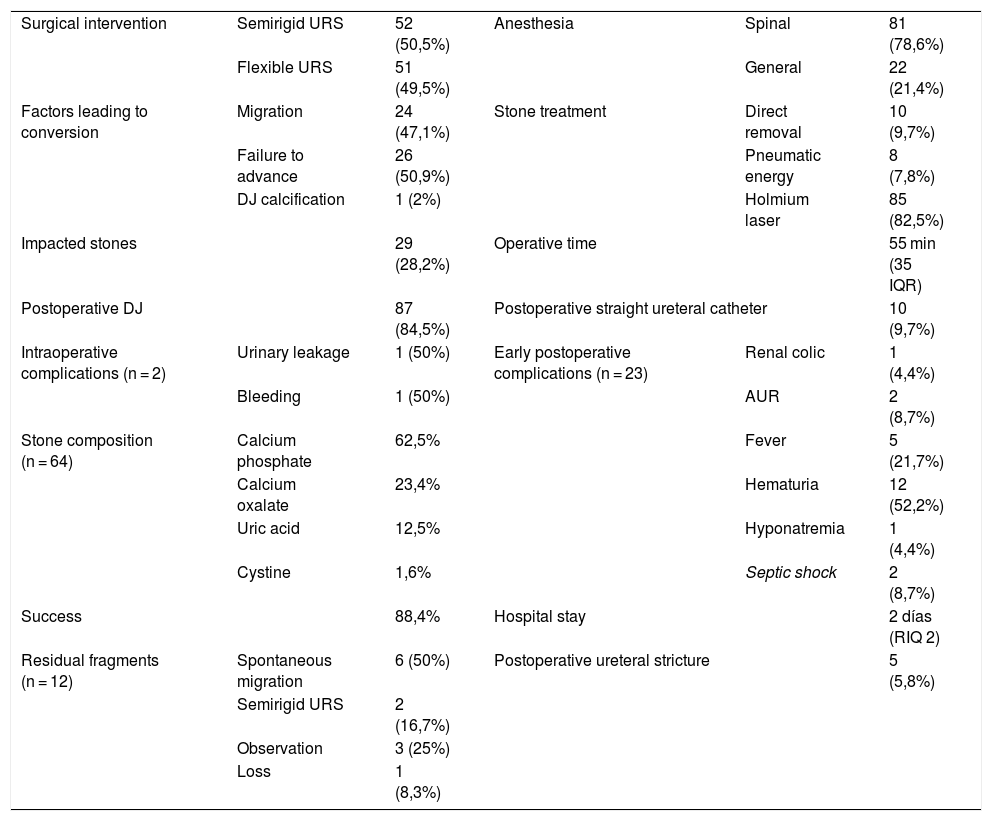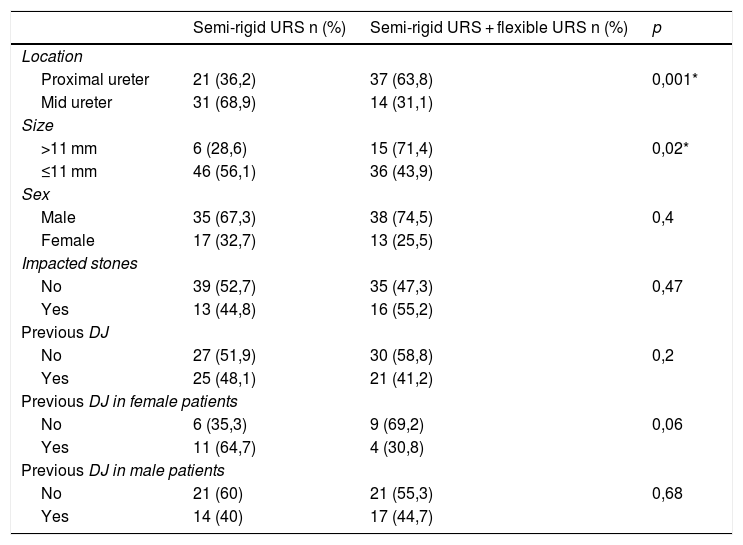Currently, there are no established criteria regarding treatment for lumbar ureteral stones. The objective of this work is to present our results in the endourological treatment of this pathology, analyzing the variables associated with the use of the flexible ureterorenoscope.
Material and methodsRetrospective review of 103 patients who underwent retrograde URS with semi-rigid or flexible ureterorenoscope. Proximal location: L2–L3. Medial location: L4–L5. Semirigid URS was the initial treatment, with conversion to flexible URS when it was required to complete the procedure. Success was defined as absence of residual fragments (6 weeks). Demographic, surgical, immediate postoperative variables, and those related to the stone, were analyzed. Their correlation with the use of the flexible ureterorenoscope was evaluated.
ResultsMean age: 57.2 years (SD 15.6); there were 73 men (70.9%). Stone size: 8 mm (range 4–30; IQR 4.5). Proximal location: 58 (56.3%). Previous JJ: 44.7%. Previous nephrostomy: 10.7%. Semirigid URS with conversion to flexible URS: 51 (49.5%). Impacted stones: 28.2%. Intraoperative complications: 2 (1.9%). Postoperative JJ: 84.5%. Immediate postoperative complications: 23 (22.3%) (Clavien-Dindo I–II: 91.3%). Postoperative ureteral stricture: 5.8%. Success: 88.4%. Residual fragments: 12 (11.7%). Spontaneous passage: 6 (50%). Greater performance of flexible URS in proximal ureteral stones (p = 0.001) of more than 11 mm (p = 0.02) in univariate analysis, and in proximal stones [OR 3.5; 1.5–8.1; p = 0.004] in multivariate analysis.
ConclusionsEndourological treatment obtained a high success rate in our sample. Size greater than 11 mm and proximal ureteral location in univariate and multivariate analysis, respectively, behaved as predictors of flexible URS.
Actualmente, no existe un criterio claro para el tratamiento de la litiasis ureteral lumbar. El objetivo de este trabajo es presentar nuestros resultados en el tratamiento endourológico de esta patología y analizar las variables que aconsejen la utilización del ureterorrenoscopio flexible.
Material y métodosRevisión retrospectiva de 103 pacientes operados mediante ureterorrenoscopia (URS) por vía retrógrada, utilizando un ureterorrenoscopio semirrígido o flexible. Se consideró localización proximal en L2–L3 y localización media en L4–L5. URS semirrígida inicial y reconversión a URS flexible cuando fue imposible finalizar la intervención o fue necesaria para completar el tratamiento. Se consideró éxito a la ausencia de fragmentos residuales (6 semanas). Se hizo un análisis de variables demográficas, litiásicas, quirúrgicas y postoperatorias inmediatas y se comparó el uso del ureterorrenoscopio flexible con algunas de ellas.
ResultadosLa edad media de los pacientes fue 57,2 años (DE 15,6); 73 eran hombres (70,9%). Tamaño litiásico: 8 mm (rango 4–30; RIQ 4,5). Localización proximal: 58 (56,3%). JJ previo: 44,7%. Nefrostomía previa: 10,7%. URS semirrígida con reconversión a URS flexible: 51 (49,5%). Litiasis impactada: 28,2%. Complicaciones intraoperatorias: 2 (1,9%). JJ postoperatorio: 84,5%. Complicaciones postoperatorias inmediatas: 23 (22,3%) (Clavien-Dindo I–II: 91,3%). Estenosis ureteral postoperatoria: 5,8%. Éxito: 88,4%. Restos: 12 (11,7%), expulsión espontánea 6 (50%). Mayor realización de URS flexible en litiasis proximales (p = 0,001) y mayores de 11 mm (p = 0,02) en análisis univariante y en litiasis proximales (OR 3,5; 1,5–8,1; p = 0,004) en análisis multivariante.
ConclusionesEl tratamiento endourológico ha obtenido un elevado porcentaje de éxito en nuestra muestra. El tamaño superior a 11 mm en análisis univariante, y la situación ureteral proximal en análisis uni y multivariante han sido factores predictores de realización de URS flexible.










